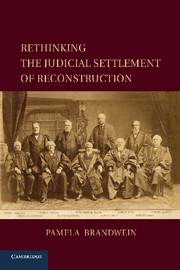Book contents
- Frontmatter
- Contents
- Acknowledgments
- 1 Abandoned Blacks?
- 2 The Emergence of the Concept of State Neglect, 1867–1873
- 3 The Civil/Social Distinction
- 4 The Birth of State Action Doctrine, 1874–1876
- 5 A Surviving Sectional Context, 1876–1891
- 6 The Civil Rights Cases and the Language of State Neglect
- 7 Definitive Judicial Abandonment, 1896–1906
- 8 Twentieth-Century Receptions
- 9 Conclusion
- Bibliography
- Index
2 - The Emergence of the Concept of State Neglect, 1867–1873
Published online by Cambridge University Press: 03 May 2011
- Frontmatter
- Contents
- Acknowledgments
- 1 Abandoned Blacks?
- 2 The Emergence of the Concept of State Neglect, 1867–1873
- 3 The Civil/Social Distinction
- 4 The Birth of State Action Doctrine, 1874–1876
- 5 A Surviving Sectional Context, 1876–1891
- 6 The Civil Rights Cases and the Language of State Neglect
- 7 Definitive Judicial Abandonment, 1896–1906
- 8 Twentieth-Century Receptions
- 9 Conclusion
- Bibliography
- Index
Summary
After the passage of the Civil Rights Act of 1866, one thing was perfectly clear: Democrats needed another plan to reestablish control over the freedmen. After the passage of the Thirteenth Amendment in 1865, Democrats had responded by passing the notorious Black Codes, reinstituting black subordination through formal rules that differentiated between blacks and whites. Reacting with outrage, Republicans passed the Civil Rights Act of 1866, which rendered the Codes inoperative. A year later, Democrats were also forced to contend with the passage of the Reconstruction Act of 1867, which granted suffrage to black men in the South and put Republicans in charge of southern legislatures. Thrown out of state capitols and now facing a black electorate, ex-Confederates could not rely on the passage of restrictive laws and the strength of the Democratic vote to resist Reconstruction. But Democrats still retained control of local law enforcement. And they could refuse to enforce the law when the Klan terrorized blacks or white Republicans. While sheriffs had ignored violence against blacks since the earliest days of Reconstruction, a pattern materialized and spread in the wake of the acts of 1866 and 1867: the local and systematic refusal to punish Klan violence and intimidation aimed at blacks, white Republicans, and Freedmen's Bureau agents. This was the practice of state neglect.
- Type
- Chapter
- Information
- Rethinking the Judicial Settlement of Reconstruction , pp. 28 - 59Publisher: Cambridge University PressPrint publication year: 2011

